These two easy recipes for laundry detergent liquid makes 14 loads of non-toxic laundry detergent for about $3.oo and rates an A on the Environmental Working Group (EWG) Healthy Cleaning scale. Learn the simple way to make liquid detergent in small batches.
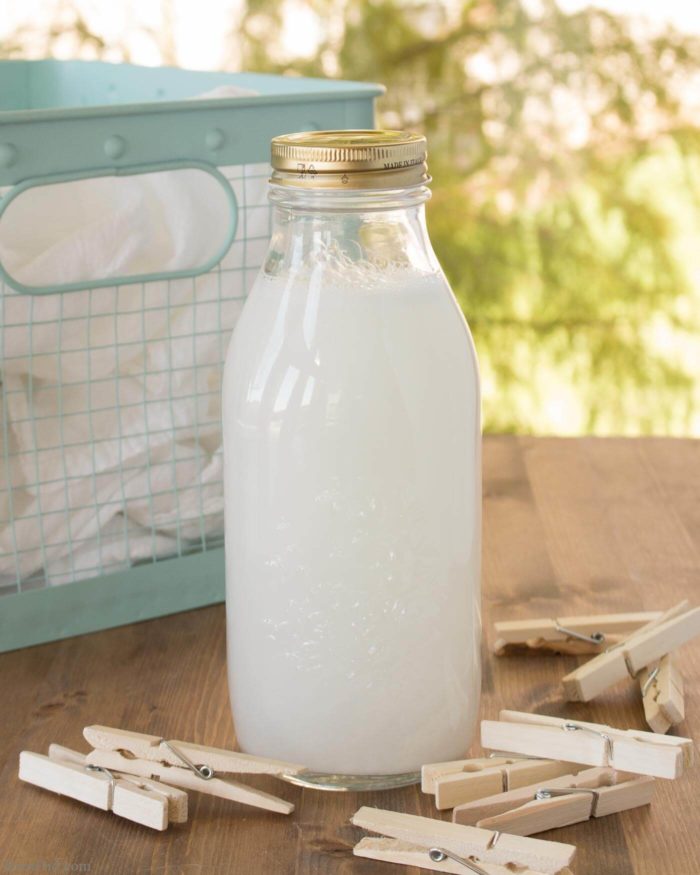
Homemade Laundry Detergent
I have been making my own natural homemade laundry detergent for close to three years. It’s an easy powdered detergent recipe that has no dangerous chemicals or additives, works great, and is cost-effective.
I love the powdered detergent but it does require grated Castile soap. Since I have not found pre-grated Castile soap this means a bit of extra effort to make the detergent.
Liquid Detergent Requests
Multiple readers have asked me to make a liquid detergent recipe, either because they don’t want to grate soap (who can blame them) or they prefer liquid detergent. I get it… I was a liquid laundry detergent user when I purchased detergent.
So, what’s taken me so long? Honestly, I could never find a liquid detergent recipe that was easy to make, worked well and didn’t produce gallons and gallons of detergent. Who has the storage space for a 5-gallon bucket of detergent anyway? And, since homemade detergent does not usually contain preservatives, I worried that these huge batches could develop mildew or mold before they were used up.
Liquid Laundry Detergent Trials
A few months ago I began making and testing my own liquid laundry detergent. My goals were simple, I wanted an effective liquid laundry detergent that:
- Does not contain Borax.
- Borax use is somewhat controversial in green circles; it is a naturally occurring mineral, but it is also toxic. Read more at MNN.
- Does not require melting or grating soap.
- Is easy to make (and store) in small batches.
- Scores well on the Environmental Working Group (EWG) Healthy Cleaning scale
It took me several months, 15 different batches of laundry detergent, and a few soapy kitchen messes… but I have succeeded!
These 2 non-toxic recipes make small batches of laundry detergent liquid using either Castile soap or Sal’s Suds. The Castile version is a bit trickier to make, but both work great and are more affordable than store-bought versions.
Version 1 – Laundry Detergent Liquid with Castile Soap
Ingredients
- Super Washing Soda – 7 oz (2/3 cup)
- Baking Soda- 1.5 oz (3 Tbsp)
- Liquid Castile soap – 1/2 cup, any scent –
- Water– 5 cups, divided
Directions
- Bring 5 cups of water to a boil.
- Pour washing soda into a large glass bowl then slowly stir in 2 cups of boiling water until washing soda is completely dissolved.
- Add one tablespoon of baking soda at a time and stir well to combine. The mixture will thicken as baking soda is added until it is a pudding-like texture.
- Stir in ½ cup Castile soap until well combined. Slowly stir in the remaining 3 cups of boiling water.
- Cool to room temperature, the mixture will separate while cooling. (I let my detergent rest overnight. See separation in the picture below.)
- Combine separated mixture by blending or whisking until smooth. (Tip: Pour the mixture into 2 quart-size Mason jars before cooling, rest overnight, then screw on a blender bottom to easily blend until smooth.)
- Store liquid detergent in a glass bottle. Use 1/3 cup per load of laundry
Healthy Cleaner Rating and Cost
This DIY laundry detergent scores an A on the Environmental Working Group (EWG) Healthy Cleaning scale.
- Each of the ingredients (baking soda, washing soda, and Castile soap) have earned the highest safety rating.
- The EWG scale was designed to protect humans and the environment from dangerous chemicals.
The detergent is cost-effective at $0.24 a load, my favorite commercial laundry detergent costs about $0.30 a load.
| Laundry Detergent Liquid with Castile | Cost per Batch | EWG Rating |
|---|---|---|
| Super Washing Soda (I use this kind.) | $0.50 | A |
| Baking Soda (I use this kind.) | $.007 | A |
| Liquid Castile Soap (I use this kind.) | $2.56 | A (or 0) |
| Total Cost | $3.13 | |
| Cost Per Load (1/3 cup or 13 loads) | $0.24 |
Notes on Using Laundry Detergent Liquid with Castile Soap
- Use a glass or stainless steel pans and utensils when making this detergent. The washing soda (Sodium Carbonate) in the solution can damage the finish on aluminum.
- Make sure to fully dissolve the washing soda completely while making or the detergent will be gritty.
- If the detergent sits for an extended period of time it many separate, stir or shake to combine.
- The detergent has a thin gel-like consistency, pour directly on top of clothes instead of using your liquid detergent dispenser.
- Use vinegar in the rinse water for extra softness. Add it to the fabric softener dispenser or use a Downy Ball filled with white vinegar. It automatically releases the vinegar during the rinse cycle.
Version 2 – Laundry Detergent Liquid with Sal’s Suds
Ingredients
- Super Washing Soda – 7 oz (2/3 c)
- Sal’s Suds – 1/2 cup
- Water – 4 cups, divided
Directions
- Bring 4 cups of water to a boil.
- Pour washing soda into a large glass bowl then slowly stir in 2 cups of boiling water until washing soda is completely dissolved.
- Stir in ½ cup Sal’s Suds until well combined. Then slowly stir in remaining 2 cups of boiling water.
- Cool to room temperature, store in a glass bottle. Use ¼ cup liquid detergent per load.
Healthy Cleaner Rating and Cost
This DIY laundry detergent scores an A on the Environmental Working Group (EWG) Healthy Cleaning scale.
- Each of the ingredients (baking soda and Sal’s Suds) have earned the highest safety rating.
- The EWG scale was designed to protect humans and the environment from dangerous chemicals.
The detergent is cost-effective at $0.26 a load, my favorite commercial laundry detergent costs about $0.30 a load.
| Laundry Detergent Liquid with Castile | Cost per batch | EWG Rating |
|---|---|---|
| Super Washing Soda (I use this kind.) | $0.50 | A |
| Sal’s Suds (I use this kind.) | $3.20 | A (or 0) |
| Total Cost | $3.70 | |
| Cost Per Load (1/4 cup or 16 loads) | $0.26 |
Notes on Using Laundry Detergent Liquid with Sal’s Suds
- Use a glass or stainless steel pans and utensils when making this detergent. The washing soda (Sodium Carbonate) in the solution can damage the finish on aluminum.
- Make sure to fully dissolve the washing soda completely while making or the detergent will be gritty.
- If the detergent sits for an extended period of time it many slightly separate, stir or shake to combine.
- Use vinegar in the rinse water for extra softness. Add it to the fabric softener dispenser or use a Downy Ball filled with white vinegar. It automatically releases the vinegar during the rinse cycle.
More Natural Laundry Solutions
If you’re concerned about chemicals in your home check out some of my other green laundry tutorials:
Natural Homemade Fabric Softener (it can be used in the washer or dryer)
All-Natural Stain Sauce for Laundry (It’s a great stain pre-treater)
All-Purpose Cleanser (it’s great for all-purpose household cleaning and laundry stains)
Natural Homemade Laundry Detergent (The original powdered detergent I have been using for years)
How to Natural Clean Smelly Towels (Learn how to get towels clean and fresh, naturally)
Like my naturally cleaning recipes? Sign up for my newsletter below and never miss a thing!


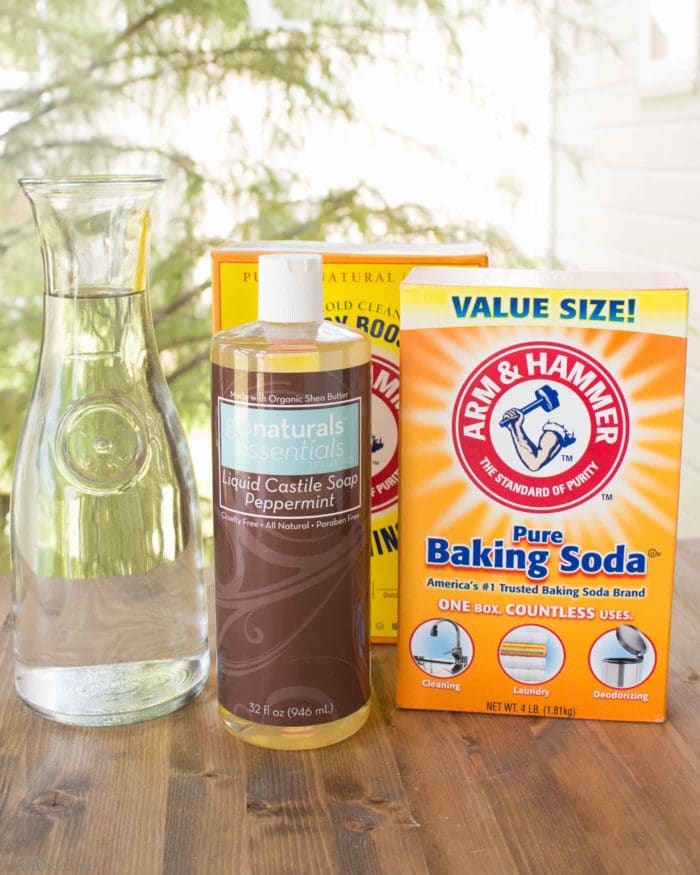
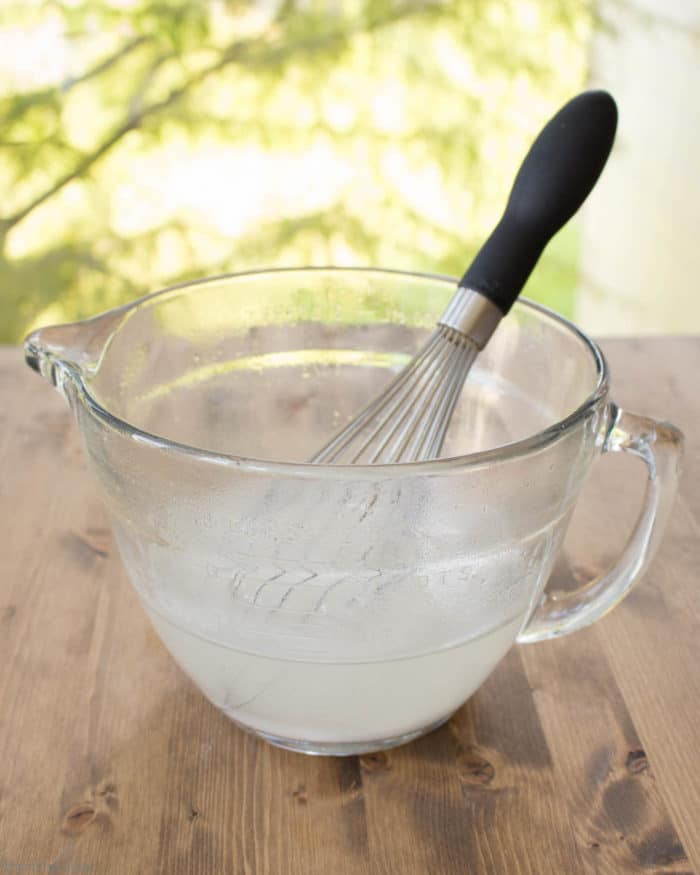
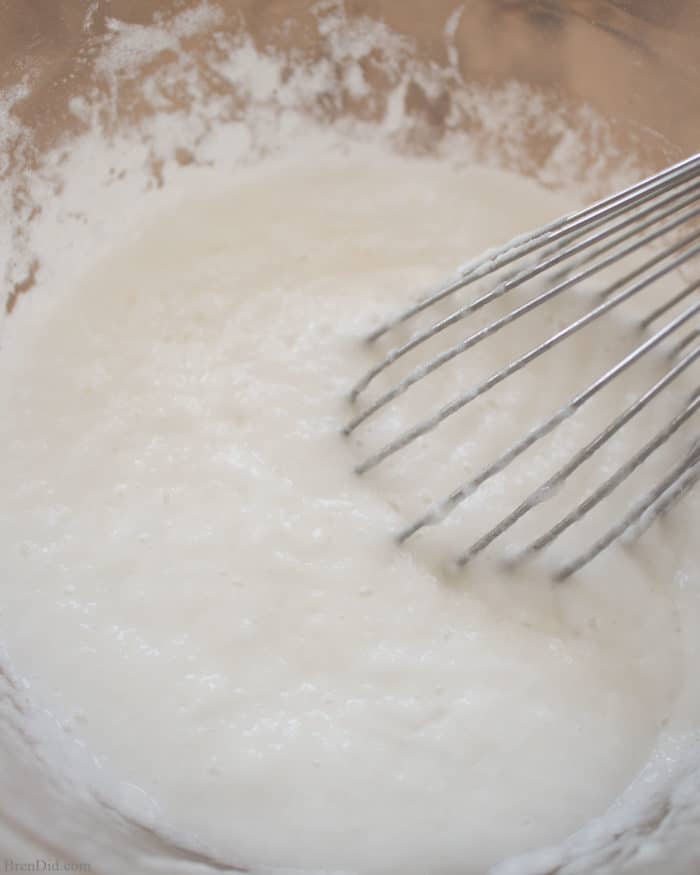
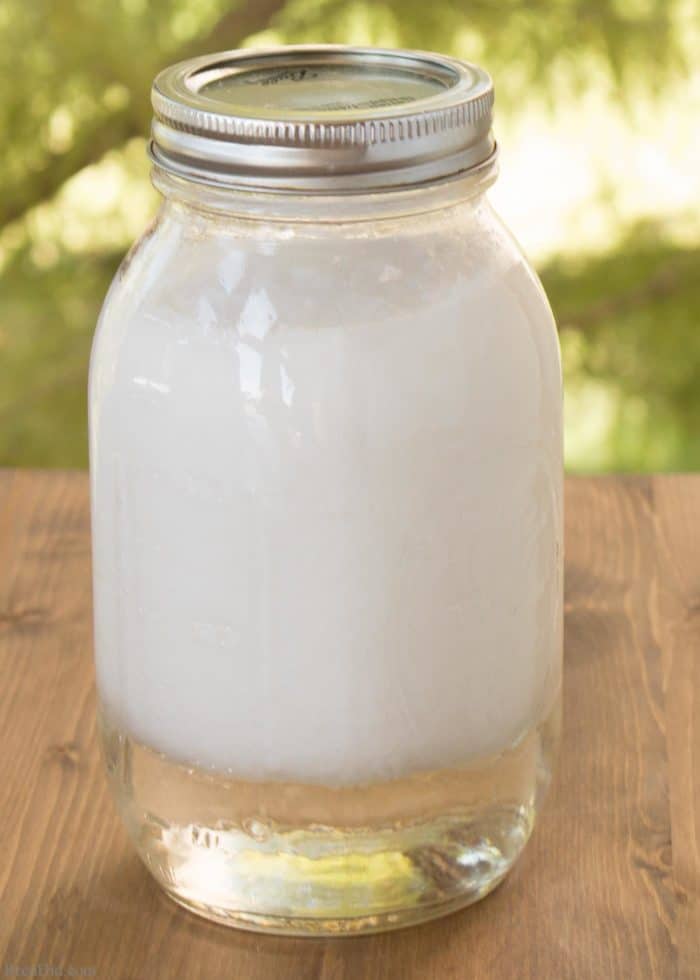
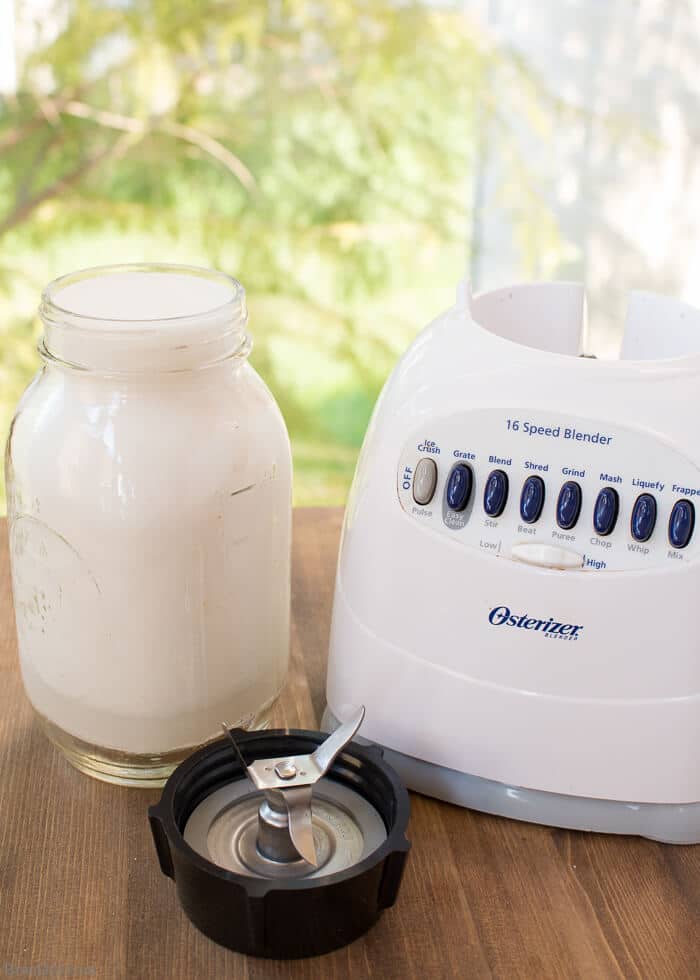
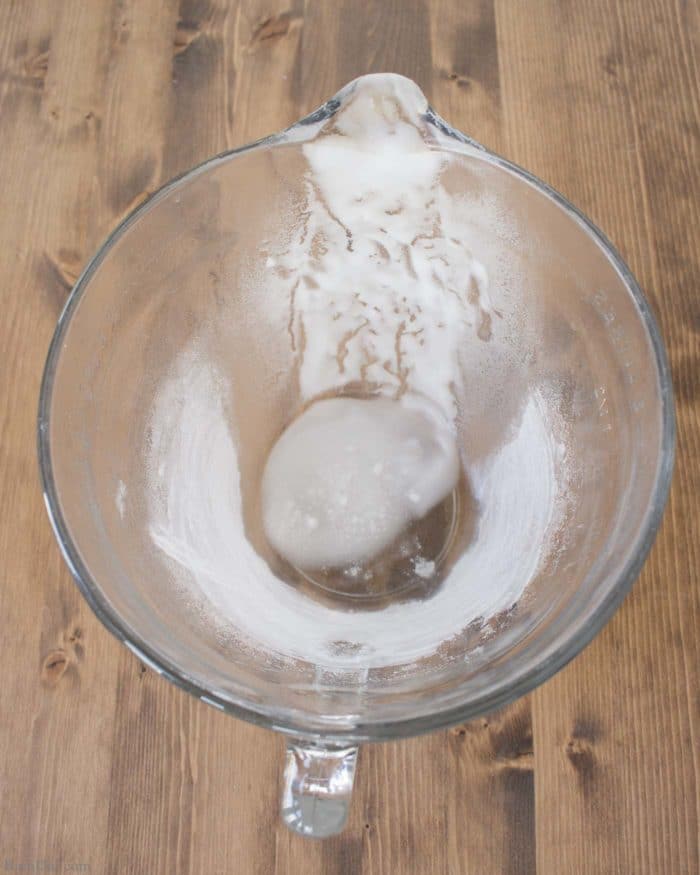
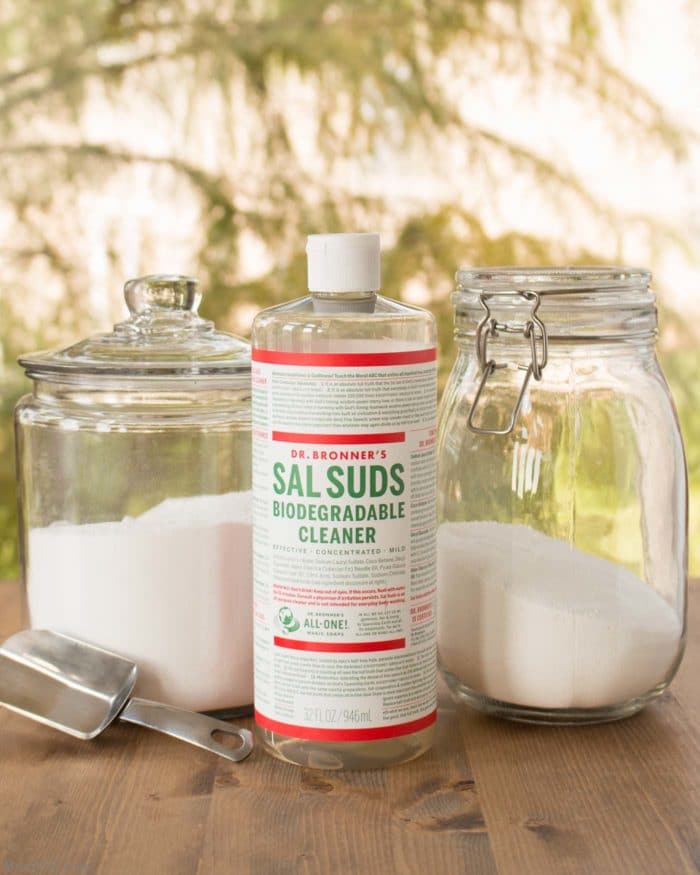
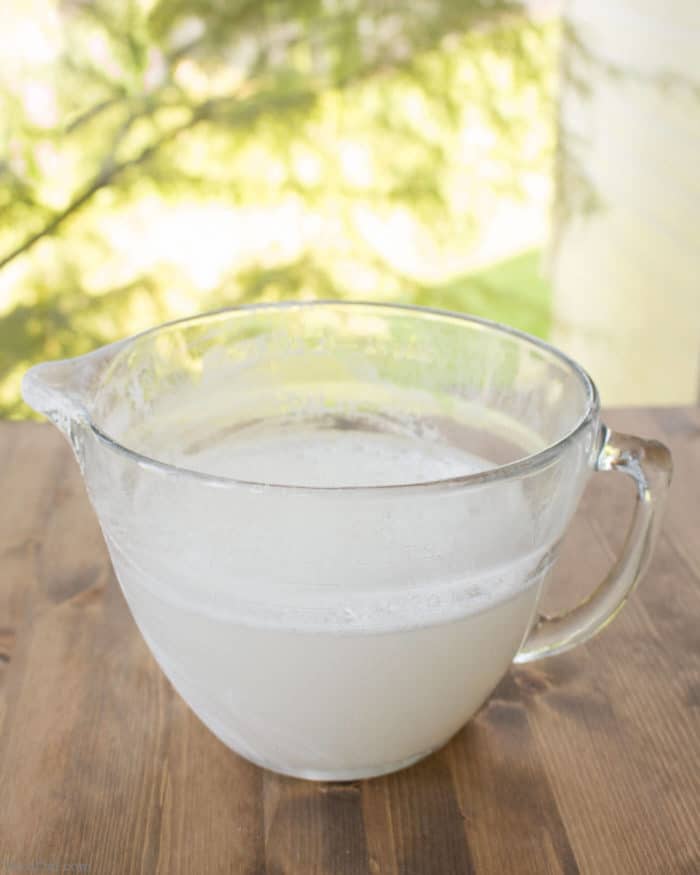
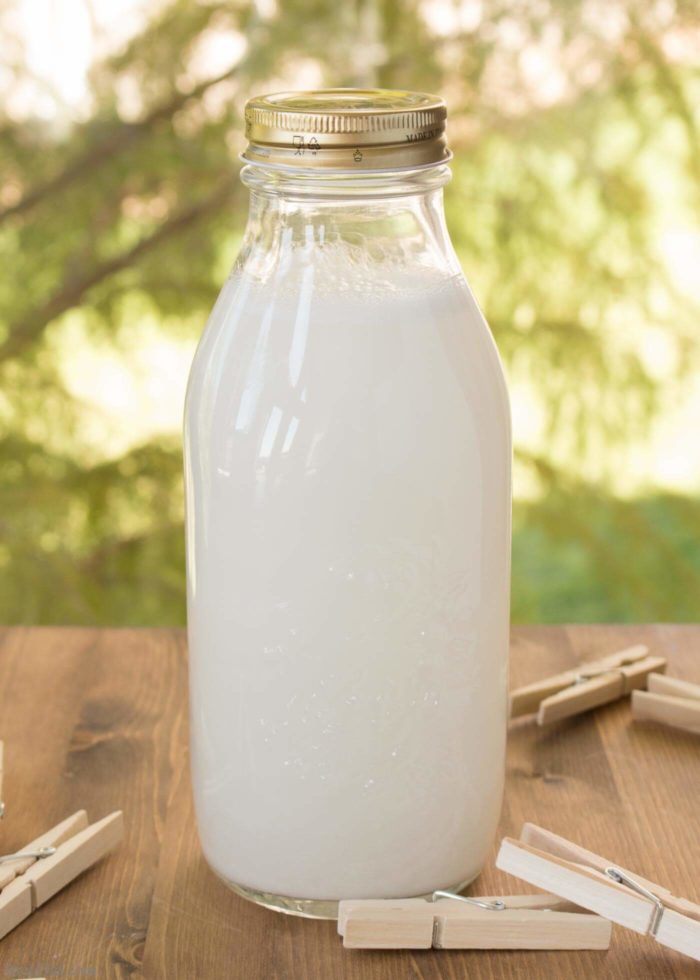
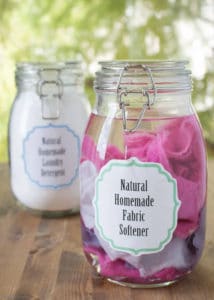
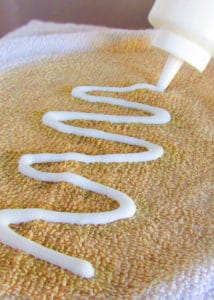
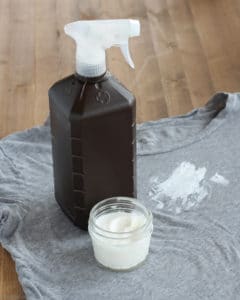
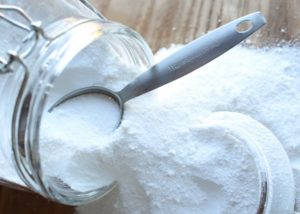
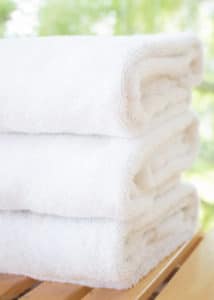

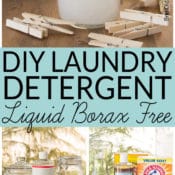
Judy
Hi Bren. I’ve been researching homemade laundry soaps/detergents, to go more non toxic. I really want to go that way. Your recipes seem so safe. I did read on goingzerowaste.com , that they are bad for your machines and leave clothes dirty due to build up. Can you help me on this?? Thank you!!
Bren
Judy, this post https://brendid.com/do-homemade-laundry-detergents-really-work/ should answer alot of your questions. Please let me know if you have more questions!
Anna
Hello!! I bought Dr. Bronner’s castile soap and I have been searching for non toxic recipes to make a large batch of detergent. I was wondering how much of this I should use for a HE side loader? I read through some comments and saw you said to see if the consistency matches store bought detergent to see if it is safe to put inside the compartment. How much does this recipe make? Thanks so much
Bren
The laundry detergent liquid makes approximately 14 loads of non-toxic laundry detergent, I would start with 2 tbsp of detergent and work your way up to 1/4 cup if needed.
Courtney
Does the LAUNDRY DETERGENT LIQUID WITH SAL’S SUDS formula work well in the washer’s liquid dispenser (unlike the Castille Soap formula which you recommend to pour over clothes instead). I have a front loading washing machine. Thanks!
Bren
I’ve used it in my dispenser without a problem however, I would check to see how thick your detergent is before you put it in the machine. If it is thicker than store-bought detergent, thin it with extra water to make sure it dispenses correctly. I would not use it in a dispenser that holds and an entire bottle of detergent, only a single-load dispenser.
Betty
I LOVE LOVE LOVE these recipes!!! I’ve been making the Sal Suds one for nearly 6 months now, and my son’s eczema has ZERO reaction to this! It’s amazing! I tried the castile soap one this weekend (Fun little project during the blizzard!) After I blended it, it turned into almost a whip-cream consistency. Is this what it’s supposed to do? I will say I think I prefer the process for the sal suds one better, it’s so simple, just mix, cool and go! I add a few drops of Purify and Lemon to this, and it smells AMAZING. It pairs so well with my homemade fabric softener that I use Lavender in! Thank you so much for these!!! <3
Bren
I’m so glad this works well for your family!
Sandy
Hi I use the first batch I made a single batch it just came out like liquid with the foamy stuff on the top and I would just shake it before I would use each load I use I’m in hammer baking soda so last night I decided to double it so I can make some for some friends and in the middle of it I had to call my husband over because it started to turn into these big white rock things.. and I had to have him try to smash them well I ended up scooping them out and throwing them out because they wouldn’t smash and when I get up this morning it was all globby on the top and some of it had like crystallized on the bottom of the one quart mason jar I used I was making it for a friend and now I don’t know whether it’s too strong or what could have happened I used sodium bicarbonate that you can buy in bulk here from a place called the chemistry store it’s the same composition what have I done wrong and it can’t be my water because I use the same water from the tap that I use the last time could it be the reaction to the essential oil that I put in at the very end when it was hot
Bren
I’m sorry you had a problem, Sandy! It could be the essential oils or the time it took to make the double batch. I would make a single batch and add the oils as you did to the double batch and that should help you figure out the culprit.
Megan
Im currently in the middle of trying this recipe. And it’s not pudding-like. The baking soda became hard chunks that I’m just smashing with the whisk to break down.. maybe things will get better by the end.
Bren
I’m sorry you’re having problems. Megan. Try to sprinkle the baking soda across the top of the mixture to keep it from clumping in a big chunk. The detergent will still work with a little grit!
Megan
Hi So my baking seemed to stay a bit clumpy I finished the rest of the recipe by adding maybe a little more boiling water. I poured into a few half quart mason jars (all I had) and let sit overnight. Just checked them and they look a bit solid but not like a rock.. kinda like when coconut oil gets cold. Should I empty them into a blender? I also don’t wanna ruin the blender haha. Or can I just scoop it and use in washer? .. on clothes or into the detergent slot ?
Melissa
Is there anything that could be added to the liquid detergent to extend the life and allow for bigger batches to be made at the same time? I can’t see myself making this every week.
Bren
You can make as much as you will use in a month and be fine without adding a preservative. I would recommend using distilled water. Good luck!
Amy R
I made the wonderful first mentioned detergent not too long ago. However, I haven’t been able to use it xet because it has a very whipped consistency that it unpourable… PLEASE HELP!!
Bren
Amy, add water and mix gently until it is pourable. Increase the amount of detergent you use per load to reflect the extra water. For example, if you add one cup of water, use about 1/2 cup of detergent per load.
Zahara
Can oxygen bleach be added to this recipe?
Bren
You can add it in the machine but not in the liquid mix. The water will activate the oxygen cleaner and you want that reaction to happen during the wash cycle. My dry detergent recipe contains oxygen bleach.
Jenny
I’ve been making this for about a year if not longer and I can’t imagine going back to store bought detergent! I have a similar reaction of a large gelatinous bowl full sometimes when I do the full 2/3 c of washing soda. I add a little water with my essential oil after it has sat overnight and take the immersion blender to it to thin it and make it scoopable. Then I just use a 1/3c scoop to load the washer. Once it’s been blended it doesn’t go back to solid gel. I’m a fan, thanks for sharing this recipe!
Bren
Thanks, Jenny!
Emily Casey
Hi! I just tried to make the version using Castile soap and after letting it sit fir a few hours it solidified!! Any suggestions on what might have gone wrong?? Thanks!
Bren
It can be a reaction to the water used. Add some water to turn it into a liquid and increase the amount you use per load to account for the extra water. Good luck!
Arianne Reiner
Hi, I’ve made this first recipe a couple times, but this time I used a different brand of Castille soap. The detergent just keeps separating into the water and a white layer on the top half even after blending a couple times. Does the impact the effectiveness of the detergent? Or can I just shake it then immediately use it?
Bren
You can shake and use!
Shell
I made the detergent without the Sal Suds, the mixture solidified and is gelatin like. Any suggestions? Is it supposed to bubble in the wash?
Bren
It will not work with Sal’s Suds which is the detergent that makes it clean well.
Cathy
So I used 1st one and I have a solid opaque gel it looks like refrigerated backon grease i used the 5cups of water 2/3c of washing soda, 3 tbsp of backing soda 1/2cup of dr bronner’s castile soap, 5drops of essential oil. Please help.
Bren
It can be a reaction to the water used. Add more water and whisk to turn it into a liquid and increase the amount you use per load to account for the extra water. Good luck!
Tracy
Thank you for all your informative information I love to.
I notice that sal suds list of ingredients, right at the top is SLS sodium laurel sulphate which in everything i read is a big no no. Can you explain how it gets an EWG rating of A?
Katie
I’m about to make the Sal’s Suds version to use to clean my microfiber cloths. Since I will be washing tiny loads, should I use a smaller amount of detergent? I have an HE top loading machine. I don’t want to gunk up my e-cloths!
Thanks!
Bren
Yes, use less when the loads are smaller.
Ana
I’ve been basically doing this by just adding the ingredients (Castile, washing soda, and baking soda) each load. It seems to be effective and worst off just wasteful because I’m not super precise and probably use too much. But is it effective? I’m lazy, but will make this if u have to! Hah
Bren
You can definitely do that!
Jordan
Great little recipe here.. I’ve been using it for about a year now and don’t plan on going back to store bought detergent. Really pleased with the results! Thank you for sharing.
Bridgett
Thank you for the recipe! I’ve read other people state that theirs turns out jello-solid and mine did the same (using 1st recipe). The bottle I wanted to use was too small for all of it so some went into a separate container, about 2 cups worth. Mine didn’t separate overnight; it turned into one solid block of jello in my glass bottle as well as the little bit in the separate bottle. We tried setting it outside in the 98 degree SC heat to see if it would liquefy but it didn’t! I tried adding just a little hot water but that didn’t do the trick. I had to add another 2 cups total of boiling water to the 2 cups worth of soap to get it to the point it would stay liquid enough to pour. Is that normal? Have I done something wrong in the recipe? I wanted to find out before I start trying to scoop the larger quantity of soap from the bigger container (a small mouth container, unfortunately!)
Bren
Different mineral contents in water can definitely mess with the gelling thickness! The next time you make the detergent you can add less washing soda or simply increase the water (like you did) and use a bit more per load.
Janice
Hi there!
If I did want to use grated soap, should I also use 1/2 cup? Or more? Thank you 😊
Love your liquid recipe btw…
Bren
Good question, Janice! You would have to make an adjustment for the amount of water in the liquid soap vs. bar soap (bar Castile soaps are around 5% water while liquid Castile soaps are around 61% water). So you would need less bar soap to equal the liquid soap in the recipe. For 1/2 cup of liquid Castile soap, you should substitute approximately 3.64 ounces of bar Castile soap (that’s about half a bar of Dr. Bronners). Hope this helps! Please note, I’ve not tried making the detergent with bar soap so I can’t promise how it will turn out! Please let me know if you try it.
Janice
Hi!
Thank you for the tips. So I did the recipe with kirks soap and I do not recommend anyone to do that 😂. I put it in a bottle afterwards like when I do it with Castile soap but it hardened so let’s say it took me a lot to take it out! Yeah, Castile soap is the best! Thanks anyway 😊
Kerry
Hi
I was just wondering if you’ve ever had any issues with your machine due to homemade detergent I’m keen to try my own but have read some articles suggesting it can damage your machine.
Thanks
Kerry
Bren
No, I’ve never had machine issues. My current HE top loader is 11 years old and working great. Of course, you should do whatever makes you comfortable! Good luck!
A. Black
Love the recipe but mine keeps turning to a jello consistency. What can I do to keep it liquid?
Bren
You can add a bit more water to thin to the desired consistency. Just up the amount, you use per load a little bit to account for the extra water.
robin gennarelli
Hi! Love this idea. Can you tell me what size bottle I should buy to store the easier liquid recipe in? Thank you!
Bren
I store mine in a 56-ounce bottle. It has a little extra room.
Erin Smith
I just made this and the solution took the finish off of the blades of my blender. I am concerned now that if I use the blender with food prep it will impart a metallic taste. Since the solution is so alkaline, may be best to use a designated non-food blender or to use a blending attachment for a power drill.
Bren
Erin, you should definitely use glass or stainless steel pans and utensils when making this detergent. The washing soda (Sodium Carbonate) in the solution can damage the finish on aluminum. If you think your blender blade has been damaged it may have been made from aluminum you should buy a replacement blade (they are usually about $10) before using it for food prep.
Suzanne Maule
Hi Bren, I have made this recipe about 4 times. Mine is never in a liquid state after I am done. Am I supposed to add more water to it the second day before blending it? Or, is the total of water only 5 cups?
Bren
Suzanne, if the detergent is too gelled you can add more water to thin it to the desired consistency, just up the amount you use per load to account for the extra water.
Diane Marie
Is it safe to store in a plastic container? When boiling in a pot does it effect your pot when you use it?
Bren
Daine, I like to store mine in glass to make sure there is no plastic leaching. You can store it in a sturdy plastic container (one that originally container detergent or cleaner). You should use only glass or stainless steel pans and utensils when making this detergent. The washing soda (Sodium Carbonate) in the solution can damage the finish on aluminum.
Jeri
I have 2 questions in reference to point 3: The mixture will thicken as baking soda is added until it is a pudding-like texture:
How long does it take for the mixture to thickens?
My stores are out of washing soda and I wondered if you have ever tried washing soda made from baking soda in the oven in this recipe?
thank you!
Bren
It thickens as it cools, sometimes this takes overnight. I have never tried making washing soda from baking soda in the oven as it is hard to be sure the chemical reaction occurred.
Tara Bublitz
Hello! Is this ok to use with HE washers? Would I need to put it directly in the drum or is it ok to place in the dispenser?
Thanks!
Tara
Bren
Tara, I use it in my top-loading HE washer. I have done both, added it to the drum and the dispenser with no problem. Of course, I always advise readers to do what they feel is best since you know your own washer!
Diane
How many cups does the liquid laundry detergent make? What is the difference between Castile soap vs Sals Suds?
I have finally discovered what was the root cause of my eczema. SLS and other junk. Since using Castile as a body wash and using it for other purposes and ridding everything that was causing and wrecking havoc on my skin.
Bren
Diane, the detergent recipe makes approximately 4.5 cups. Castile soap is a true liquid soap made from vegetable oils, Sals Suds is a detergent made from coconuts. Hope one of the recipes helps your skin!
Rose
Hi, Bren! I’m loving your site! 🙂 I just clicked on your link to purchase the Sal’s Suds – which I didn’t know before – and I read on amazon’s description that it contains SLS. That made me a little concerned, and I read above that Diane is also avoiding SLS due to eczema.
So, I’m here wondering how EWG rates Sal’s Suds A (or 0), or completely safe to health, once we have known from other sources (and from Diane’s comment above) that Sodium Lauryl Sulfate isn’t that great for our skin.
I understand that the SLS in this reciper of yours is not having direct contact with our skin, because the clothes will be rinsed afterwards anyway. So, it might not be a big deal. But still, I don’t understand how a product with SLS can be rated A.
Have you ever tried a substitute ingredient without SLS? I’d imagine it might not clean as well… what do you say? I have, so far, used Dr Bronner’s “soap” in my laundry (it’s even a little cheaper than Sal’s Sud). I also use it to wash dishes. It works great! But it’s not a cleaning agent, so for really grease dishes or grimmy socks I must use more of it to get a good result. But it’s 100% safe!
At any rate, thanks for all the tips! Your site is well put together and has great content! 🙂
Ashley
The Sal Suds bottle has a little explanation on Sodium Lauryl Sulfate on it.. and to not have it confused with Sodium Laureth Sulfate. When used in small quantities and rinsed off it is safe to use.
Tessa
I made my own laundry detergent for years but towards the end continually battled odors in our clothes. I honestly think this had more to do with the curse of the front loaders than anything but I eventually quit and switched to just using an eyeballed Tbs. of straight Sal Suds. Overall this has worked very well but at times I feel like it could be better, and maybe stretched a bit more for cost savings. Your straightforward approach and understanding of which items to combine, and which to not, has inspired me to try again. Out of curiosity, which do you think works better – your powdered recipe or the liquid recipe with Sal Suds? I’d love to know!! Thanks for all your great info!
Bren
Tessa, if you like to wash in cold water I like the liquid best if you wash in warm I like the convenience of making the large batch of dry detergent.
Tessa
Thanks for replying. Why the difference with the temperatures? I originally thought I read that the powder works better with warm water but then on your Laundry FAQ post you said that you use it in cold. I just made up the powdered version because I hadn’t seen this reply yet. I do wash everything on cold except towels.
I love your site and get sucked in every time I stop by. Haha! One bit of feedback, if there is some way to be alerted when you reply to our comments, that would be wonderful. I’ve left comments on a few different posts of yours and then I have to remember to check to see if there’s a response.
Thanks for all you do.
Bren
Tessa, I do use both detergents in cold and have no problems. However, some homes (my parents’ house for example) have super cold well water that does not dissolve the detergent well. If this happens, you can usually solve the problem by adding the powdered detergent to the machine first or dissolving it in a little warm water then adding to the machine. Hope this clarifies my first answer, lots of readers have different laundry conditions/machines so it’s hard to give a precise answer for each situation. 🙂 Glad you’re loving the site! I’ll check into the comments notifications. You can also message me on the Facebook page, I tend to get to those more quickly.
Dace
Hi Bren,
Thank you for the recipe. I’ve already used one bach of detergent and it seems working well 🙂
Although I have concern why my detergent stayed liquid (no gelish feeling). Just now made my second bach and added 4 Tbsp of baking soda but no better effect.
Do you have any idea what could be the reason for not thickening? Water, castille soap brand..?
Thank you!
Stay well!
Bren
Dace, it cal be differences in the minerals in the water, different brands of Castille soap, etc. The good news is the detergent cleans well even if it doesn’t gel (as long as you use the ingredients indicated).
Nina
I’ve made this recipe around 6 times now and have been using it A LOT. Unfortunately, over and over again, it ends up leaving white-ish stains on my black as well as dark blue clothing. Only on light-colored clothing are the stains not visible. I wonder, what could be the cause of this? I’ve done so many different loads and have made this recipe 6 times – the detergent itself always seems fine. I wash my clothing with 30*, 30-45 minutes. Any idea what the root cause could be for the stains on my clothing? My washing machine is new btw and I’ve done about 50 loads with it since so it’s gotta be from the detergent.
Bren
Nina, sorry you’re having a problem. I’ve never had white stains with this recipe but it sounds like a problem with the washing soda or baking soda in the detergent dissolving completely. You can try mixing the detergent with extra water before adding it to your machine or use an extra rinse cycle. Are you using vinegar in the rinse water? That can help excess detergent rinse out. It might take some experimenting to see what works best with your machine. Good luck!
Rachel
Hi, I posted a comment yesterday, not sure if it went through. My detergent came out very fluffy and thick. It didn’t separate. Is that normal?? I followed the directions exactly.
Thanks,
Rachel
Bren
Rachel, the detergent doesn’t always separate. You can simply stir it if it does not. If it is too thick you can add a bit more water, just increase the amount you use per load. Either way, it should still clean great.
Flower
I’ve been very excited to find this blog and am learning from it! It shows more careful research than all natural DIY type teachers do. Yesterday I did two laundry loads with your liquid laundry detergent recipe (Sal’s Suds + super washing soda + water). So far so good. I slept very well in the freshly laundered pajamas, socks, and bedding.
I like the simplicity of owning few ingredients and few, easy recipes so am looking forward to also trying your dish detergent and all-purpose spray recipes which also use only Sal’s Suds + washing soda + water. Sounds like the all-purpose spray is simply the dish detergent diluted with more water.
Yesterday made just 1/4 the Sal’s Suds liquid laundry detergent recipe. Today will try a half batch and hope it’ll go even better, especially since I just read all the comments so I see those extra tips.
Two issues. (1) The way it’s worded I’m not sure how much water you mean. (2) A lot of the boiling mixture was getting all stuck to the bottom of the pan (stainless steel pan, not non-stick). I don’t want to hurt my new pan by scraping metal spoon along it as if it’s a spatula when scrambling eggs. Should I get a wooden spoon or whisk? Lower heat?
Flower
P.S. A little tip. I began sharing someone’s washer and drier which were pretty dirty, and wanted to cut down on germs and for laundry to work well. So before doing laundry I scrubbed with sponge every bit of each inside and out with non-toxic soap and water, wiped off well with paper towels I threw out, got all lint residue off, then ran a load of just hottest water and around 1/2 cup Clorox bleach with extra rinse cycle. And swept well. Not a huge fan of bleach but with Coronavirus worries thought that all seemed smart. I’d also like to sanitize their outer surfaces once in awhile but haven’t picked sanitizer yet, maybe just diluted bleach.
Flower
Hi again, I ended up realizing I slightly read the directions wrong. So tried it again a few times since then and I love it!!
Kasey
Hi everyone! I was determined to make this recipe work and be “pourable”. I have a few tips that I thought I would share.
1. I used 2 Tbsp of baking soda, instead of 3
2. As the detergent was cooling, I set a timer to stir with a whisk every 15 minutes. Once I noticed it beginning to thicken, I decreased my time to stir to every 5 minutes.
This is more labor intensive, but it worked and I am very pleased!! No more thick sludge!
Bren
Thanks for sharing your tips, Kasey!
Louise Schultz
Was really excited to try this. Cooked it up yesterday & let it cool overnight. The next day, it was like Jell-O. Is that normal?
So I wisked in a little bit more water to thin it down a bit. Didn’t want to dilute the solution. It still seems a bit gelatinous though. Is that ok?
Bren
Louise, adding more water to thin the detergent is just fine! Just remember to use a bit more per load to account for the extra water. It will also work when it is more gelled. Good luck!
Ap
I tried making your version 1 of laundry detergent and mine came out really thick and looking like wiped cream 😬 after blending it like you suggested.🤔 I’m still going to try the detergent in my laundry to see if it still works but with a small load of towels or something. Thank you for all your hard work and researching this homemade detergent.👍
Bren
Amy, you can add more water to thin until you get the consistency you desire then just up the amount you use per load to account for the extra water. Good luck!
Bri
Thank you for this recipe!! This is my 3rd time making it and I tripled the recipe & seems great so far!! My baking soda separated into little small chunks even after I sifted it… I’m going to try distilled water next time!!
Von
Hi Bren!
For the past 4 years, I’ve been researching & trying out new safer homemade laundry cleaners with no satisfying results. So, I KNOW how much time, effort, COST, and aggravation it can be. Therefore, I very much appreciate all the effort you put in and share! Your information/analysis/reasons have come the closest to my own experiences as to why some recipes haven’t worked. In any case, I’m about to try your liquid Sal Sud’s version. But, just out of curiosity, in your cost break down you mention, “my favorite commercial laundry detergent”. What is that detergent? I like to keep a store bought detergent on hand when in between my failed homemade attempts.
Bren
Von, I currently like Puracy, Biokleen and Whole Foods 365 unscented detergent.
Katt
I have made your #1 detergent several times and love it! Laundry is clean and smells nice. I use vinegar for fabric softener and haven’t had to buy detergent or softener for a long time! I feel better knowing the ingredients are safe and cheap! Thanks for a great recipe! I plan on using more of your recipes too!
Bren
Thanks, Katt! I’m glad it is working well for you!
Kelli
Hi Bren, just made my first batch, excited to see how it turns out! Quick question though: Is there a shelf life to the castile detergent? I would like to make a double or triple batch so I don’t have to do it as often. Would there be any issues with that?
Bren
Kelli, I do not think you would have a problem storing a larger batch as long as the storage container is airtight so it doesn’t evaporate. Hope you like the detergent!
Kellie
Thank you so much for the laundry detergent recipe. I cannot wait to make it. I absolutely love the scent of francinscense and myrrh in my detergent. Do you think that I can add essential oils to your dry version? I know that it would be much easier to do so in the liquid recipe but I prefer dry detergent. What do you think? and if Yes, at what point in the recipe? I am going to add that scent to the liquid fabric softener too! You can never have enough of that scent!!
Bren
You can add essential oils but the scent will wash out with the laundry water. I would add them to the baking soda to distribute then add to the mix.
Kb3k
I tried making the first recipe with the washing and baking soda. When i added the baking soda, it turned in to hard rocks that did not dissolve and the mixture did not thicken. Any ideas why? Maybe it was old?
Bren
I could be your water. Different minerals/hardness levels can affect the recipes differently. Using distilled water can help.
Crystal
You mentioned in your #1 laundry detergent recipe (baking soda), to not put your liquid Laundry detergent in the detergent dispenser? What about your #2 laundry detergent recipe (Sals Suds), can it be put in the detergent dispenser?
Thank you
Bren
I do not use my powdered laundry detergent in the detergent dispenser. I have had no problem using the liquid detergent in the dispenser. Good luck!
Florianne Calleya-Jones
Hello,
Im from Sydney Australia and I cannot wait to make the castille soap recipe two questions though:
– do I need to shake the detergent before using
– can I store into their drink dispenser (glass) or is it too thick?
thanks
Bren
You should not need to shake before using if it properly combines. I store in a glass bottle. I am not sure what a drink dispenser is, sorry!
Ashley
Could any of these be used for an (he) washer?
Bren
I use them both in my HE washer.
Miranda
Why does my detergent end up super thick? It has the texture of a thick moisturizer when I make it.
Bren
It can be thicker due to difference in water. Add a bit more water to thin then up the amount you use. It will still work great!
Kasey
Once my detergent cools, it is so thick that I can’t seemed to thin it out and make it smooth. It is the consistency of peanut butter. Maybe less baking soda next time? I’ve mixed it with a whisk as much as I can and still the same. Not sure what to do. Added a little more water even. Thoughts?
Bren
Kasey, you can add more water to thin the detergent until you get a pourable consistency just remember to use a bit more per load to account for the extra water. Good luck!
Audrey
Hello Bren,
Thank you for your laundry soap recipes! I’m curious why you took out baking soda from the recipe with Sal suds? I’ve seen some recipes online that use both washing soda and baking soda.
Thank you!
Bren
Audrey, I did not find it necessary in the Sal’s Suds version. You can add a scoop to the washer if you think it is needed.
Sam
Does it have to go in glass? I have an old large laundry detergent plastic jug that I’d like to use
Bren
I like to use glass to prevent leaching, you can use whatever you feel safe using!
jmason
Can I use Dawn (original blue) instead of Sal’s Suds? I know it won’t be natural but I’d like to used what I have on hand instead buying more stuff. When I use up the Dawn I’ll get the Sal’s Suds. Thank you.
Bren
I’ve not make it with Dawn so I am not sure how it will work. Let me know if you try.
Jayda Kate
Hi, have you encountered the first recipe to turn into more of like a solid jelly like consistency once cooled?
Bren
It can gel due to different mineral content in water, just whisk in more water until you reach the desired thickness. You may have to use a bit more per load due to the increased water content, but it will still clean great.
Janyce
I’ve made the first recipe a couple of times and I love the detergent but my consistency is closer to a lotion than a liquid. Any suggestions? When I’ve let it cool, mine doesn’t separate. Thanks!
Bren
You can whisk in more water once cooled to reach the desired consistency then use a bit more per load to make up for the extra water content.
Layal
HI Bren,
It is okay to add essential oils for smells to this laundry recipe? It won’ react with anything will it?
Bren
It will make the detergent smell, but will wash out in the rinse. Read more here.
Amy G
This is my first time making the Castile soap laundry detergent. I followed instructions exactly as written but mine did not thicken after adding baking soda. Will this affect the laundry detergent at all? Either way I’m excited to try this detergent tomorrow. Thanks for the recipe.😀
Bren
It will still clean great! Good luck!
Shannon
Have you heard of Oxo Brite? I was wondering if you could substitute the Oxo Brite for the Washing Soda? The Oxo Brite has; Sodium Carbonate Peroxide (mineral-based stain remover), Sodium Carbonate (mineral-based water softener), Sodium Metasilicate (pH adjuster). Where as washing soda only has Sodium Carbonate. Do you think it would work better?
Bren
I’ve never tried Oxo Brite in the recipe so I can’t be sure how it would react. Sorry!
Tree
Which detergent do u like better or that cleans betters, the powder one of liquid versions?
dawn
i’m curious why you add the sals suds, then the remaining 2 cups of boiling water. will the recipe not come out right if you added all four cups of water at the same time to dissolve the washing soda, and then added the sals suds?
Jaquella Eckles
I live in South Korea and want to make the first option of laundry detergent, so I’ve got to order the liquid castile soap. I’ve been finding castile soap with and without shea butter. Though, there are more scent options (which I’d prefer) with the ones with the added fair trade shea butter. (Dr. Woods, Tea Tree Castile Soap with Fair Trade Shea Butter, for example). Do you think that would make a difference or should I stick to castile soap without the shea butter?
Bren
I would not use shea butter versions, they are great for skin as they moisturize but might make laundry greasy.
TC Clark
Since I have Multiple Chemical Sensitivity disease, I’d prefer not to use the Dr. Bronzer ‘s Sal’sSuds since the scents make me ill. I’ve used the Dr. B’s Hemp Unscented Pure Castile Soap for general cleaning and find it works well and I can tolerate it. Can I use it in place of the Sal’s In all of your Sal’s recipes? Also, I’d prefer not to use washing soda at all, so can I use just baking soda in it’s place in all your recipes calling for washing soda? Lastly, doesn’t hydrogen peroxide discolor or “bleach” colored fabrics? Is there an effective sanitizing alternative ingredient to peroxide that I can use in your recipes?
Thank you, Bren, for any help you can offer.
Bren
TC, the substitutions depend on the recipe. Castille soap should not be mixed with vinegar and baking soda is not always a good alternative to washing soda. Hydrogen peroxide will bleach some items if use at too high a concentration. Alcohol (aka vodka) an also be used to sanitize. Please let me know if you have specific questions and I can help more!
Mariah
Made the castile laundry soap! Smells amazing but yea like others said turned into thick whip cream! I made in in my blender maybe thats why…..
Bren
Let it rest overnight so the foam subsides then add some water to get to the desired consistency. Good luck!
Joanna Warren
I need help!! I have been trying to make this laundry soap and have no success. I am on my second attempt and both times in the cooling process the soap turns into a thick gel and there is no separation. I blend it an it looks like frosting. I don’t understand why. I follow your directions to the ‘T” and I still don’t have Liquid. also when I put in the baking soda it doesn’t dissolve it forms little blocks at the bottom of the bowl. I had to get my hand mixer out to mix the mixture then it came to a pudding like state, but it is still to thick I am using the exact products you are using. I am putting in exactly 5 cups of water. I am so lost on what I am doing wrong. Please help! I have just used the soap anyway with out adding extra water and our clothes are clean. I would prefer the liquid over any other detergent.
Bren
Joanna, different types of water (mineral content differences) can make the detergent gel differently. Just add more water and stir until you reach the desired consistency. You’ll need to add a bit more per load since it will be more diluted but it will still work. Good luck!
Linda Rees
I plan on making Sal’s Suds Liquid laundry detergent for the first time; just waiting for Amazon to deliver the super washing soda. I have a water softener and need to know if I should decrease the 1/4 cup of detergent per load due to the soft water. I hadn’t seen this question asked in reading the comments. Thanks
Bren
I would not decrease the detergent unless there are residual suds after your first load. Good luck!
Erica
Do you think it would negatively impact the outcome if a halved the recipe? There are only 2 of us at home and didn’t want the extra detergent sitting for a long time if it did not have to. Thanks!
Bren
It should work the same if you make half. Good luck!
Jess
Hiya I don’t know what I’m doing wrong but my Castile version won’t go thick at the beginning at all I just have a very watery liquid what am I doing wrong??
Bren
Jess, it can simply be differences in the water (different minerals, etc). The detergent will still work the same even if it doesn’t gel!
LeighAnn
For those commenting that it’s too thick, I have a few pointers from trial and error on my end. Before you add the water to the washing soda, break apart the washing soda to where every bit of it is a fine powder. Then follow the rest of the directions and while you are combining all of the ingredients, be sure the leave of the remaining three cups of water boiling on the stove until the moment you add it. These little things made the difference in an unscoopable gloppy mess and actual liquid detergent. 🙂
Bren
Great pointers, LeighAnn!
Tree
Does the liquid detergent with sal suds clean better than the liquid detergent with Castillo soap? Does the powdered detergent with kirks Castille soap and oxi clean clean better than both liquid recipes? Which one do u use most often?
Bren
I use the powdered detergent most often. I do not mind using powdered detergent. If making liquid I use the Sal’s Suds version. Good luck!
Dolores
Hi. I would like to try to make the laundry detergent with Sal’s Suds and l was wondering if this recipe is ok for he machines.
Bren
I use it in my HE top loader with no problem!
Muktak
Hi! Super thanks for this great work! I made liquid laundry using your recepie ( with castile soap) and it came out to be very viscous/ too thick in the end. Is there something you would recommend to thin its consistency ?
Bren
Muktak, you can add additional water to thin the detergent to the desired consistency. Make sure to increase the amount you use per load to account for the extra water. Good luck! -Bren
Muktak
great! Will do that. Thank you so much 🙂
Angela
Muktak,
How did adding extra water work out for you? I just made a batch of the Castile soap recipe, and after blending a bit, it came out like whipped cream! Also using this in a HE top loader.
Thanks!
Shelley
Hi Bren, Thanks for this recipe. I just wondered about coloured clothes, is this OK, or will it strip the colour out? Not sure what the difference is between the “colour” and “regular” commercial detergents but I had a bad experience of a black wash going grey recently and now I’m a bit paranoid! Thanks for any guidance 🙂
Bren
Shelly, I’ve not had a problem with colors fading. The more gentle the detergent the less fading it should do to clothes. I like to wash all my darks together (without denim) on warm or cool. Hope this helps! -Bren
Shelley
Thanks Bren, I’ll give it a go! 🙂
Julie
Hi Bren. Thank you for sharing your recipes. I tried making the liquid laundry detergent and bought a great jar from the dollarstore. It looked great, but went to use it and my liquid is solid as a rock …LOL. Not sure how that happened. The only thing I did differetly was use my had mixer on low to mix everything really well. Any ideas on what went wrong and if it can be fixed?
Bren
Different types of water can make it gel differently. Just add more water and re-blend. You’ll need to add a bit more per load since it will be more diluted. Good luck!
Julie
Thank you. That worked. When I made my second batch, I figured out what I did wrong. I didn’t let it cool quite enough before pouring into a bottle.
Bren
So glad it worked!
Heather
Hello Bren! Thank you for sharing your recipe. I went with the sals suds recipe and washed a couple of loads last night. Only thing I noticed is that a couple of pieces came out with small blotches, kind of what looks like when fabric softener stains the clothes. I used 1/4 cup of the detergent along with 1/4 cup of vinegar as the softener. Did this ever happen to you? I’m not sure what could have caused the blotches. Thank you!
Bren
Did you add the vinegar at the same time as the detergent or in the rinse?
Andrea
I made this and when it cooled, it was completely clear. (Washed my clothes well, too!) Then as it sat overnight in my basement, it turned white and I had a big, hard clump of solids and some liquid tha separated. Stirring seems to help, but I imagine that blending it again would fix this. Is there a way to keep it from clumping? Having to blend it before each use would be a nuisance.
Bren
Andrea, this sounds completely normal. The first gelling/separating does not happen for me until I leave the detergent resting overnight. At this point, I blend the mixture (with my blender) and it stays suspended. Hope you enjoy the detergent!
Heather
I’m having troouboe getting the washing soda to dissolve completely, even by slowly stirring in the boiling water. And I’m not getting a light gel consistency it’s much more liquidy. It is separating like your picture. Any insight into what I’m doing wrong?
Bren
It can depend on the makeup of your water. You can try using distilled water or wait overnight as blend as directed. It will still clean even if it is not a gel. Good luck!
Karma
Do u like the powder detergent diy or the liquid one better? which one cleans better to u?
Bren
I prefer the powdered version because it makes more (and takes less time to make). They both clean well. Hope you find a version you enjoy!
Jo
Hi Bren, just a quick question. I made this recently and my entire this is liquid and clear – didn’t get any pudding like texture after the baking soda. It’s not a gel considtency either. Didn’t even have to blend it because it is totally liquid. Is that alright or should I be adding more ingredients?
Bren
It’s perfectly fine as long as you used the indicated amount of ingredients. Different water can make it gel differently. It will still clean the same.
Crystal Wells
hello. I just made your recipe and when sitting out to get to room temperature mine never really separated. By the time it was room temp it looked like clear liquid detergent. Is this normal? Just wanted to make sure I didn’t do anything wrong. I followed the directions but never had a separation more than just a foamy layer on top that dissolved by the time it got to room temperature
Bren
It’s completely fine if it doesn’t separate… as long as you used the same amount of ingredients in the recipe it will clean the same!
Tulips
I just made your laundry recipe, the first one. It is the first time I try a homemade laundry soap and I cant wait to see the first batch of laundry. Thanks for posting and making my life greener 🙂
Bren
Hope you like the detergent!
Arline Stoffberg
Hi Im not sure this question heas been asked
Does this soap work well with cold/cool wash?
Bren
Yes, it can be used with cold. Good luck!
Lian Ellison
I just made the laundry liquid with Sal’s Suds and I wanted to tell you how happy I am with it. It was easy to make and the results are awesome!! Even without using any kind of softener it leaves my towels much softer than any commercial, chemical liquid ever did! Thanks so much 🙏🏼
Bren
Woooo hoooooo! I am glad the detergent is working well for you! 😉
Andrea
Thank you for posting this recipe- it’s very well explained and isn’t a huge amount! I had to make my own washing soda by baking the baking soda, and then used it in this recipie, but it turned out completely liquid. Since it is not a gel, does it still need to be blended for immulsification, or can it be used as it is now? Also, is it as potent if it has not formed a gel at all, or is the ⅓ cup still enough?
Thank you!
Andrea
Bren
You can use the liquid as is. It will be the smae potency if you added the same amount of water as the recipe (and your baking soda actually turned to washing soda) so ⅓ cup is enough for a load. Hope you enjoy!
Kandis Campbell
can you add some type of essential oil for smell? if so, how much? and if not, what can you use to make it smell good?
Bren
Commercial detergents are scented with man made chemicals that coat laundry. Natural substance cannot not make laundry detergent smell as strongly as artificially scents. To add a gentle, natural scent you can use scented Castile soap in place of the non-scented Castile soap, make natural Fabric Softener to soften and lightly scent laundry in the dryer, or spritz clean laundry with natural Fabric and Room Refresher Spray before folding.
Essential oils are natural and safe to use in laundry, but wash out with the rinse water. Laundry comes out of the machine VERY faintly scented or smelling like nothing. Any remaining essential oil scent will disappear in the dryer. Read more in my Laundry Detergent Q & A.
Shelby
Hi there! I’d love to try this homemade recipe but I was wondering if you know if these products are cruelty free? I try not to support companies/products that use animal products or do animal testing.
Thanks!
Bren
Dr Bronner products (the Castille soap and Sal’s Suds used) are certified cruelty-free and there is no animal testing done with them. (Read more here: https://www.drbronner.com/faqs/.) Church & Dwight (the makes of Arm & Hammer Baking soda and Super Washing Soda) say they do not test on animals. (Read more here: https://churchdwight.com/our-brands/animal-testing-policy.aspx). Hope this helps!
Melissa
Hey so, I have a stupid question. How exactly would you attach the Mason jars to a blender base to mix the soap. I know if you have a bullet you could just attach the blender piece to the jar but not sure about a regular blender
Melissa
I’m planning to make this but I was curious if this was safe to use with cloth diapers. Looking for a laundry soap that will last a while and be safe on baby cloths
Bren
Melissa, I have never washed diapers with this detergent (my kids were out of diapers before I developed it). I do wash everything else in it with no problem. If you have concerns I would check with you diaper manufacturer to be safe! Good luck, Bren
Melissa
I checked with my mom who makes her own soaps and said it shouldn’t harm them at all. This recipe is great and I plan to make it tomorrow. Thank you so much for your recipe
Kim Jameson
I love your Blog! Thank you for all of the info and free printables! Such fun!
I saw that you mentioned to put the detergent right on top of clothing and not dispenser for #1 above… but not for #2 (using Sals Suds). I have a front loader and cannot add prior with a big mess. Will the dispenser still get a thin coat of gel like if I use Sals vs Castille (in HE front loader washer)?
Bren
Hey, Kim! I put my homemade detergent on top of the clothes for all my recipes to make sure they get into the ash compartment and do not clog the dispenser. Can you add some clothes, pour on the soap and then continue adding your laundry?
vikky
Good idea to put the mixture in the box/tin.
Just a question or something I would like to share,; I already made this recipe myself for such a long time, never cooked this just used distilled water and as the Sal Suds contains some oil I always add essential oils in this before adding into the water.
Bren
Thanks for the tip, Vikky!
Lisa
Help please. I made this last night. Whisked everything until it was clear slightly gel-like. I woke up this morning and it is completely solidified!
Bren
Don’t panic! Just add a bit more water and blend. Repeat until you get the consistency you desire. Remember to increase the amount you use per load slightly since you are adding more water.
Jade
Hi I’ve made the washing liquid twice now but mine is really watery and I do not get the pudding-like texture that you describe after adding the bicarbonate soda. What am I doing wrong?
Bren
It might be your water. Try making the recipe with distilled water next time to see if it makes a difference. (Even without the thick texture it should work just fine!)
Heather
I read your recipe and was planning to use it yesterday. But being the minimalist I am (lazy?) I just used Sal”s Suds. Prior to that I have been using perfume/dye-free major detergent, for years. I wanted to change because I have had to double rinse everything due to itching and still the fabrics irritated my skin, the detergent was taking too my dye out of my dark clothes, and seemed to be causing my clothes to “age”–that is, get holes etc, faster than ever. With the Sal’s Suds I used regular wash cycles, whites and colored clothes separately, all cold, no double rinse, and regular drying time. Everything turned out great! Softer, less battered, and no itch! We have extremely hard water here. My question is, what does the Washing Soda do? I bought it, and am ready to use it, but wanted to know what to expect. Is it for greater stain removal? The clothes I washed yesterday weren’t all that dirty. Also, I really dislike the smell of Sal’s Suds, and was delighted to discover that the smell was completely gone after the dryer. Thanks!
Bren
Heather, you can definitely use Sal’s Suds on it’s own. I like to use washing soda for extra brightening and stain l. It lowers the PH of the water (read more here in my post about washing soda).
Rita Avancini
Hi,
I haven’t tried your recipes yet but thanks for your great suggestions and R&D.
Wouldn’t be better to use distilled water to avoid variations in tap water that can compromised the recipes results?
Best,
Rita
Bren
Yes, you can use distilled water if you have it available. The thickness of the soap is not particularly important so I don’t mind the variations. Hope you give it a try. -Bren
Sheila
Hey, Does the first liquid detergent recipe work as well as your borax free dry recipe?
Also, in your dry recipe you use Oxi Clean Baby but not in the liquid- may I ask why?
Bren
Sheila: Question 1: Yes, the first liquid detergent recipe work as well as my borax free dry detergent recipe. Question 2: No, you can not add Oxiclean to the liquid soap recipe. The liquid will react with Oxiclean in the mix and it will lose its effectiveness. If you want to add Oxiclean you can add a scoop directly to that machine when doing laundry. Good luck!
Christine
I’ve made this twice so far but both times mine is like a solid block. I followed the ijnstructions exactly. I’m using the washing and baking soda with water and Castile soap. How can I remedy this, do I add more water? I didn’t want to water it down.
Bren
Christine, I would add more hot water to loosen it up. It can just be a difference in the type of water or how long it boils. Just add s little extra detergent to the wash to make up for the extra water in the detergent.
Donna
Have you read the blog by butterbeliever.com? I’m not sure what to believe. But her bashing of diy laundry detergent ends with buy this detergent and /or sell it as a wholesaler. I’m confused as what to believe.
Bren
Thanks for writing, Donna. I have not read that blog but I am familiar with the complaints against homemade laundry detergent. My short answer is this: How well the homemade detergent works depends on the ingredients used to make it. There are alot of detergent recipes online that are really, really questionable. I’ve been using my homemade detergent for years and have had no problems with my machine or laundry. If you want to read my LONG explanation you can read my post “Does Homemade Laundry Detergent Really Work?” Hope this helps! Let me know if you have more questions.
Donna
Thank you so much. I ❤️Your recipe and have been using it for months. I am doing the 2nd option with 7oz washing soda 4 cups boiled water and 1/2 c sal suds. It’s amazing and I have never had such a clean front loader. I also use an immersion blender so I don’t have to whisk so hard. I am off to read that post you mentioned now. Thanks again
Lisa
In recipe #2 can I use essential oils in it to make it have a scent? If so how many drops should I use. Thanks! I am looking forward to trying out this recipe!
Bren
Lisa, you can add essential oils (they will not hurt the detergent recipe) however the scent will wash out with the rinse water. Laundry comes out of the machine VERY faintly scented or smelling like nothing. Any remaining essential oil scent will disappear in the dryer. I prefer to add my essential oils to a wool dryer ball or my homemade fabric softener.
Vanessa
I’m excited to try this recipe! How many loads does this recipe make? Thanks!
Bren
Each recipe makes 14 loads of non-toxic laundry detergent. Hope you like the recipe!
Claudia
Hello 🙂 thank you for your page. I am loving it. I am so glad that i found it. I have a question about your first VERSION 1 – LAUNDRY DETERGENT LIQUID WITH CASTILE SOAP. Can i use other soap and that is not liquid? And in this recipe, you didn’t use oxiclean. Can i use it and how much?
Thank you for your answer. Greetings from Europe
Bren
Claudia,
You can not add Oxiclean to the liquid soap recipe. Question 1 – The liquid will react with Oxiclean in the mix and it will lose it’s effectiveness. If you want to add Oxiclean try my powdered detergent recipe or add a scoop directly to that machine when doing laundry. Question 2 – I’ve never made this version wtih bar soap. If you want a bar soap detergent I’d try the powdered detergent recipe. Good luck!
Anna
Hi there! Excited to try these however in the recipe #2 it lists “liquid castille” instead of “sals suds” – I’m assuming they aren’t the same since there are two different recipes. Also, is there a reason baking soda isn’t in the second recipe? Is it just not necessary b/c it’s sal’s suds vs. castille? Thanks!
Bren
Anna, Castille soap is a plant based soap while Sal’s Suds is a coconut based detergent. The soap recipe needs a bit more “umph” from the baking soda while the Sal’s Suds recipe works well without it. You can read more about detergent vs soap in my post Do Homemade Laundry Detergent Really Work. Let me know if you have more questions! Bren
Angela Yeung
Can it be used right after it’s made or have to wait until it cools down? I am getting little lumps of powder balls forming at the bottom.
Bren
You can use it after you complete all the steps including cooling and blending. Good luck!
gabriela
So they both have the same grade toxicity? And also will they keep colored close the same but still work well on white clothes? Also does the clothes smell like vinegar and how much do u uses of it? What’s the toxic rate on vinegar?
Bren
Gabriela, both version of the detergent rate an A on the Environmental Working Group (EWG) Healthy Cleaning scale. I use them on both colored and white laundry. No, the clothes do not smell like vinegar when they are done washing. I use about 1/2 a cup of white vinegar per load (I fill the fabric softener dispenser in my machine). VInegar rates an A on the EWG Healthy Cleaning Scale.
Danielle
So excited to try this recipe! One question: What is the reason for dumping the liquid detergent directly on the clothes? I have a new Samsung front-loading washer and it is more convenient to use the detergent drawer. I don’t want to mess it up though so I will follow your direction if it’s important! Thanks! 🙂
Bren
If the detergent is a thin liquid when you are finished making the detergent I would feel fine it in the drawer. However, the recipe can “gel up” and get very thick. In this case I feel better using it directly on top of my clothes so I don’t risk clogging detergent dispenser. Hope this answers your question.
Clare stiles
Hi, I’ve just made the soap flakes version and it didn’t thicken when the baking soda was added? Does that matter? I used less water as a result and will use less in a load!
Bren
It should work just fine, Clare. I agree with your decision to use less a load if you used less water.
Emilee
Hi! I just made this recipe for the laundry soap using the Castile soap and it turned almost gelatinous!? I followed the recipe exactly. Any ideas how to fix?
Bren
It’s okay if it gels, Emilee. You can use it as a gel (just scoop on top of the laundry) or add more water to thin it. If you add more water you will need to use a bit more per load since it will be more diluted. Good luck!
Kaitlyn
For your favorite Grade A Borax free Laundry Powder, you just pour directly onto the clothes correct?
I am having a hard time deciding whether or not to do the liquid or powder!! I have used liquid ever since I can remember!
Bren
I pour both the Grade A Borax Free Laundry Detergent and the Liquid Laundry Detergent directly on top of the clothes. Before I made my own powdered detergent I only used liquid detergent, now I mostly use powdered!
Kaitlyn
Can essential oil be added to make it have a smell?
Jenna
Hi, I just made this and am running a load of laundry right now. 1/3 cup doesn’t seem to be enough. The water doesn’t feel soapy at all and there are no bubbles. Is that normal? I just want to make sure the clothes are getting clean. It’s a pretty large load. Thanks.
Bren
This detergent will not bubble much at all. I would try a load and see how you think it worked before adding more per load. Good luck!
Laura O
Hi. I made this is a pure liquid. Both sodas dissolved pretty quickly. I bought a different brand of laundry soap (not Arm & Hammer), so not sure if that would affect it. Should I add some more? It is pretty much a pure liquid detergent. Thanks!
Bren
DId you mean a different brand of baking soda (Arm & Hammer)? If it is pure baking soda it will not make a difference. It’s okay if the detergent is a liquid not a gel it will still work the same.
Liz Bee
I waited 2 weeks to leave this comment. I made the liquid laundry detergent with Sal’s Suds. I’ve put this detergent through the test for 2 weeks. This recipe is awesome. I’ve used it on my husband’s workout clothes, towels, and my son’s stinky clothes. It actually takes all the bad odor out of the clothes. It’s amazing on musky towels. I’ve tried everything to get rid of that musky towel smell. So, I used this recipe on the towels and it actually worked. No musky smell. It actually smells like nothing…the towels smell like nothing. I can’t believe it actually worked on the towels. And it’s cheap to make. And it’s homemade. Unbelievable. Thank you for this recipe.
Bren
Thanks for commenting, Liz! I’m so glad the recipe is working great for you!
Liz Bee
I have a question. I too had trouble dissolving the washing soda. I tried all your recommendations to dissolve, but it didn’t dissolve completely. I have a gas stove. One thing that worked for me was to pour some of the boiling water into the glass bowl. Then place the glass bowl directly on top of the stovetop grate, under simmer heat. Then, I stirred 2 tablespoons of washing soda until completely dissolved, then added additional 2 tablespoons at a time until completely dissolved, and continued to do this. It hasn’t blown up in my face or caught on fire. But my question is, does the washing soda lose its potency if I put it directly on top of the grate on simmer heat? Should I be worried flammability?
My rationale:
The reason why I put the glass bowl on the stove with simmer heat is because I felt that as I added the soda in the water, the temperature may have gotten cooler which prevented the washing soda from dissolving. So I figured, if I put it on the stove, there is constant heat. I’m not sure if this a good rationale or not. Now I’m concerned that maybe I messed with the potency.
Bren
I would not put the glass bowl directly over the flame for fear that the bowl would break. If you want to keep the water hot you can place the glass bowl full of water on top of a pan 1/4 full of boiling water. The pan is over the heat not the bowl. (You are essentially making a double boiler.) The water boiling in the pan keeps the water in the glass bowl hot. Choose a bowl that fits tightly over the pan and be careful not to let the pan boil dry. Hope this makes sense!
Liz Bee
Yes, thank you for the advice. Oh, does this technique decrease it’s potency?
Bren
No, it should not change the potency (as long as you do not leave it on the heat for an extended period of time).
Sarah
Hello! I am wanting to try your liquid detergent.
When I added the baking soda to the water after the washing soda dissolves, it just hardens, and I can’t get the baking soda to dissolve.
I tried adding it to cold water first, but then the water doesn’t gel up. Am I doing this wrong, or do I need to stir the baking soda longer after it goes into the hot water?
Thanks!
Bren
Sarah, try sprinkling the baking soda (one tablespoon at a time) across the top of the hot water and stir to dissolve before adding the next tablespoon. If it doesn’t dissolve 100% the detergent will still work just give it a shake before using. The sprinkling should keep the detergent from developing any large lumps. Good luck!
Keira
I’m having this same problem. (Whisking/smashing the baking soda while typing) I had already read this comment & reply, so I made sure to sprinkle it in, (actually only got 1/2Tbsp) & it created a sheet on top of the water. It’s now broken into little flakes & clumps, but not dissolving. I’ve been smashing & stirring it with my wisk, but it doesn’t seem to be making much difference. Guess I’ll keep trying.
Bren
Sorry you’re having problems, Keira. Is you water very hot? The detergent will still work with some undissolved baking soda just shake before using.
Sarah
Thank you!
I’ll try that. 🙂
Sarah Rose
Hi,
I made this earlier today and my detergent has turned into a foam-like consistency, can I still use it? It’s like more liquidy but a foam. Let me know!
Bren
If you used the same ingredients as the recipe it should still work great! Hope you enjoy!
AmandaH
In the instructions you tell us when to add the 2cups out if the 5.. but when do you add the remaining 3 cups? I read the instructions multiple times but couldn’t find where.. is it during the mixing in the blender process? I want to make sure I’m making it right. Thanks!
Bren
It’s in step 4 – “Stir in ½ cup Castile soap until well combined. Slowly stir in remaining 3 cups of boiling water.” Hope you like the detergent.
marina
If I dump the gel on the clothes, it is just on one spot. Will it spread well?
ALso, I found the second step : the baking soda is very hard to melt well in hot water. any suggestion?
Thanks
Bren
Mariana, yes the liquid detergent will spread when added to the laundry. If it is too thick you can thin it with additional water. Try adding the baking soda a little at a time to make it easier to combine. Good luck! -Bren
Pam
Hi,
I made the detergent with castile a week ago, its turned into a nearly solid state. Its not liquid enough for a good shaking. Any ideas what happened?
Bren
It can be a variation in water hardness or the brand of castile used. You can still use the soap, just blend it with a stick blender or give it a whirl in the blender. You can add a bit more water while blending if desired (blend first then see if it needs more water). Hope this helps!
Becky
Have you ever tried adding Epsom salt to you laundry detergent. I had read it softens the water and is a good fabric softener. Thoughts on adding it to these recipes?
Thanks!
Bren
Becky, I have used it in my powdered detergent but didn’t think it made much of a difference so I use white vinegar in the rinse instead.
Heather
I use Epsom and Washing Soda in my homemade laundry powder
Jasmine
Hi! Love your blog and these recipes – the simpler, the better! I was wondering if you could store either recipes into a recycled plastic bottle? I have an old Seventh Generation laundry bottle I’d like to use for this and was wondering if that’d be an issue? I live in a complex with a shared laundry room so I’d like to avoid transporting glass back and forth. Thanks in advance!
Bren
Jasmine, great question! You should be fine storing it in a recycled laundry detergent bottle. I would make sure the mixture is cool before pouring it into the bottle since the boiling water could leach chemicals from the plastic. Good luck!
Tolley
Is this ok to use in an HE washer?
Bren
I use it in my HE top loader washing machine. I put the detergent on top of the clothes not in the dispenser.
Tanja
I live in Australia and would love to try your detergents, but am not sure what the equivalent ingredients would be here. Can you help me please
Bren
Hi, Tanja. What ingredient are you unsure about?
Tanja
Hi Bren
The washing soda. I have never heard of that. Is it like baking soda which I think is bicarbonate of soda.
Thank you for clarifying it for me as I can’t wait to try out the recipes.
Tanja
Bren
Tanja, washing soda is Sodium Carbonate (Na2CO3). You can read about the differences between washing soda and baking soda here. Let me know if you have more questions! 🙂
Saskia
Washing soda is called Soda Crystals in the UK. Is that what it’s called in Australia too?
Bren
I’m not sure if that is the Australian name or not. Sorry!I would check the ingredients to see if it says Sodium Carbonate (Na2CO3).
Carly
You can get washing soda in bulk at The Source stores 🙂
Bren
Thanks, Carly! Great tip for those in Australia, New Zealand and the UK.
Donna coutu
I’m trying to get the house completely switched over from store bought to natural homemade cleaning and hygiene products by may. I’ve found great recipes for certain thing but still have to be careful due to certain diseases, one of which is Celiac Disease, I have not tried laundry detergent yet.
Have you heard from anyone with Celiac or other heath issues about how this detergent works for them? Do you recommend the Castile or seals suds with health issues and skin sensitivities
Bren
We have sensitive skin (eczema) in our house and I use the Castile soap version. I primarily use my homemade powdered detergent. I do use Sal’s Suds for cleaning. I am not sure about Celiac Disease and the detergent, sorry!
Karen
This is the second time I’ve made this it’s great no grating feels naptha( my family hated the smell I had to do it outside). No five gallon bucket to find room for and no stirring of the detergent before decanting it usually spilled or the drill we used for mixing the stuff usually went all over the place. I can use my extra large ball jars. My family does not do fragrance of any kind so this works for them too. Nobody is breaking out with any rashes it’s a winner for us. Another boon is the small amount means less outlay of money and it’s extremely easy to make. By the way I have a front loading machine.
Thank you.
Bren
I’m so glad you like the recipe, Karen! I made powdered detergent with grated castile too, but I agree it’s nice to not have to grate.
Clarissa
I’m stoked to try these out – I have such sensitive skin it’s actually really difficult to find brands I can use on my clothes! This will be a great alternative – I don’t know why I’ve never thought of making my own (duh!)
-Clarissa @ theviewfromhere.is
Bren
Thanks Clarissa! My favorite laundy detergent is my Grade A Borax Free Laundry Powder, it makes 320 loads! This liquid version is great for smaller batches and people who like liquid detergent.
Karen
Would you also use the same amount?
Bren
Yes, use the same amount in a HE or regular machine.
Karen
Could you use this in an HE machine and would you put it in the dispenser?
Jodie
Karen, Did you get an answer to this? I don’t see one.
Thank you!
Bren
You use the same amount in a HE or regular machine. Hope you like the DIY laundry detergent!
Jodie
Thank you! Just made it! So excited to try it today!